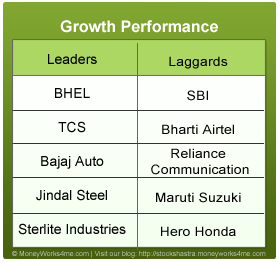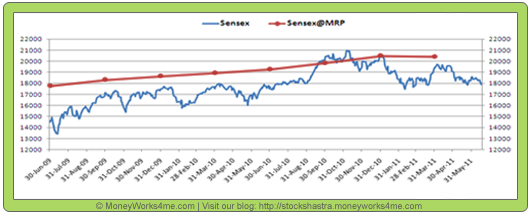
As investors, we are used to seeing the Sensex move every minute. And to make investing more profitable and not a game of mere chance we need a solution. A solution which could help us ascertain whether the market is over-reacting or under-reacting, whether it is grossly depressed or irrationally exuberant. This is exactly what Sensex@MRP is!
Considering that the Sensex stocks are the top traded stocks of the country, we can expect them to be traded at their MRPs. In reality, the stocks are driven by their earnings over the long terms. Hence, it is said that Market is a slave of the corporate earnings. Sensex@MRP – based on the earnings of the Sensex companies – gives you an indication of whether the Sensex is fairly valued or whether irrationality is driving the markets.
Most of you must have gone through our earlier reports about Sensex@MRP which explained to you how the concept works and can help individual investors. So, with the March 2011 quarter results out for the Sensex companies, where does the Sensex@MRP stand?
The free float market capitalization at the MRP of the individual stocks as computed by us at MoneyWorks4me.com and using share data as on 16th June 2011 is Rs. 1,658,845 Cr. Using the index divisor 80.07 (as on 16th June 2011) the Sensex@MRP comes out to 20,717.

Sensex@MRP for the March 2011 quarter is slightly higher (1%) than the December 2010 figure of 20,504. Compared to the earlier quarters when Sensex@MRP showed a rise of close to 3%, the increase has been low. The 1% increase in Sensex@MRP has been a result of an increase of more than 5% in the MRP of 6 companies which have shown good performance and together account for 20% of the total weight. In comparison, 5 companies (accounting for 6.5% of the total weight) saw their MRP drop by more than 5% due to poor performance.
While Sensex@MRP has virtually remained flat, Sensex which is close to 17,985 (as of 16th June), is 12% or 2440 points below the Sensex@MRP. This after it had reached close to 19,000 in March 2011. The last couple of months have seen major selling across all segments. This has been a result of headwinds such high inflation and rising interest rates which are expected to affect the profitability of the Indian companies going forward. The weak Western and European market coupled with higher crude oil prices have added to the negative sentiments across the Indian market.
But are these fears justified? Has the profit growth of the Sensex companies really started to slow down? Let’s have a look at the annual and quarterly results of the Sensex companies to see how they actually performed.
A closer look at earnings
Quarterly Performance:
Out of the 30 companies, 24 registered a growth of more than 12% in Net Sales on a Y-o-Y basis. As a whole, the March 2011 quarter saw an increase of around 24.19% (Y-o-Y) in Net Sales for the Sensex. The growth was majorly supported by sectors like Banks, Automobiles, IT and Metal. The sectors, where growth was below average included Oil & Gas and Telecom. Bharti Airtel and ONGC reported a moderate growth of 8-10% while Reliance Infra and Tata Power reported negative growth in Net Sales (Y-o-Y). Going forward, the Net Sales growth rate is expected to stay more or less stagnant due to rising interest rates and inflation.
On an operating level, the operating profits of the Sensex companies came down by 6.76% in March 2011 as compared to March 2010 quarter and by around 16.85% as compared to December 2010. Higher raw material prices were the major reason for this fall. Also, the higher provisioning and increase in under recovery share of upstream companies affected the Banking and Oil & Gas industries respectively, pulling down the operating profits for the Sensex as a whole.
As far as the net profitability of the Sensex companies is concerned, adjusted PAT grew by close to 7.39% as compared to March 2010 but was down by around 2.76% as compared to December 2010 quarter. Among the 30 companies, 24 companies recorded a Y-o-Y growth in earnings, and 21 companies recorded a Q-o-Q growth in earnings while rest reported drop in earnings.
Full Year Performance:

Analysis of the full year performance of the Sensex companies reveals that the leaders from the Sensex pack have been BHEL, TCS, Bajaj Auto, Jindal Steel and Sterlite Industries. Bajaj Auto outperformed in the automobile space with around 50% profit growth as compared to FY 10 on back of higher demand in the market. Jindal Steel continued with its stellar performance seen in the last quarters and registered 29.7% and 39.5% growth in Net Sales and Net Profit respectively. BHEL and TCS too continued their impressive growth and outperformed in their respective industry. Sterlite posted 23.5% growth in Net Sales and 34.7% growth in Net Profits backed by higher metal prices and increase volume of zinc production.
The year has been one of the worse for the telecom companies – Reliance Communications and Bharti Airtel – due to intense competition and higher expenses. Bharti Airtel has seen a 18% (y-o-y) fall in profits whereas Reliance Communication has reported loss of Rs. 764 Cr. A surprise entry to the list of laggards this year has been SBI. Though SBI posted good credit growth, its profit suffered considerably due to significant increase in provisions for non-performing assets (NPA). Auto majors Maruti Suzuki and Hero Honda recorded a growth of more than 20% in topline but margins declined by around 8-10% due to increase in raw material costs.
Of the 30 Sensex companies, 20 companies registered a growth in Net Profits whereas 10 companies registered a fall as compared to FY 2010.
So, what should we as investors do??
The rising raw material prices continued to be a major concern for the companies as well as the RBI. As a result RBI continued with its steps to hike interest rates in order to reign in the inflation. So, while companies suffered on the raw material front, going ahead, rising interest costs are further expected to dent profitability. Going ahead capex projects may get delayed leading to lower growth in sales. Also sectors like Auto, Banking and Capital Goods may suffer due to lower demand. Companies which will be impacted the most are the ones who are highly leveraged and do not have sufficient pricing power.
With the fall seen in the market, 21 of the 30 Sensex companies are quoting below their MRP (this number was 19 for the December quarter) whereas the rest 9 are quoting above their MRP.
Considering the global and domestic economic situation, we expect the gap between Sensex and Sensex@MRP to widen further as selling pressure continues across all the segments due to decline in investors’ confidence. While the market is expected to remain volatile in the short term, it looks attractive for the long term. Thus, buying opportunities are expected to increase going forward.
As investors, the best thing to do now is to look for companies who are not burdened by high debt and command pricing power considering the inflationary environment. Investors should look to buy such fundamentally strong companies at a high discount (healthy margin of safety), and hold them for long term.
Buying opportunities are expected to increase going forward. Make sure that you buy a company which is fundamentally strong and is available at a healthy margin of safety.
To do this make sure you check the MRP of your stock on MoneyWorks4me.com.
Disclaimer:This publication has been prepared solely for information purpose and does not constitute a solicitation to any person to buy or sell a security. It does not constitute a personal recommendation or take into account the particular investment objectives, financial situations or needs of an individual client or a corporate/s or any entity/ies. The person should use his/her own judgment while taking investment decisions.
If you liked what you read and would like to put it in to practice Register at MoneyWorks4me.com. You will get amazing FREE features that will enable you to invest in Stocks and Mutual Funds the right way.
Need help on Investing? And more….Puchho Befikar
Kyunki yeh paise ka mamala hai
Start Chat | Request a Callback | Call 020 6725 8333 | WhatsApp 8055769463









Nice quaterly and yearly review….. expecting nifty@MRP:disqus soon as it reflects broader basket of top50 companies…..
Regards
Jagadees
Excellent guide to decide when not to be greedy or fearful and how much to buy at what price level when sensex is considerably below sensex @ MRP. Shibaji Dash.
Very useful and easy to understand analysis.Predictions made in June have come true.From August I found the companies I have shortlisted becoming increasingly cheaper.I am sure my investments being made in these companies since August will help in increasing my wealth.Thanks.